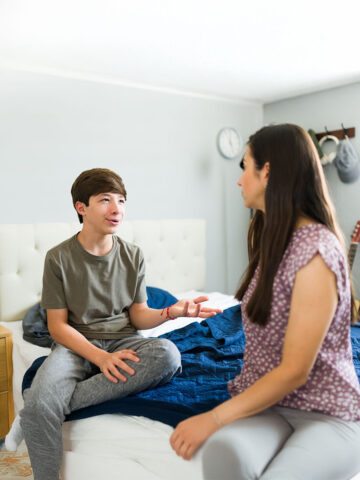Transitioning from carefree summer days into a structured school day can be stressful for children. From a change in environment to new names and faces, heading back to school can be a stomachache-inducing, palms-sweating time for many kids and teens.
Many parents wonder if kids are faking these feelings to get out of going, but back-to-school anxiety is a real phenomenon, says Dr. Christopher Min, a pediatric psychologist at CHOC. Back to school anxiety occurs when nervousness goes into overdrive, causing physical, behavioral or cognitive consequences that can impact a child’s mindset and ability to perform in school.
“It’s easy for us as adults to forget what it’s like to be a kid,” Min says. “It can be really scary.”

A child’s job is to go to school, Min says, and their workload doesn’t simply include academics. School is where they learn and practice everything from social skills with peers and authority figures, to learning boundaries and appropriate behavior, to practicing physical activity, to selecting food on their own and eating without their parents.
“The likelihood that at least one of these things will create apprehension or anxiety in kids is great,” Min says. “So many things are packed into one environment.”
It’s important for parents to remember that children are just starting to learn these life skills when they’re in school.
“Not only are kids asked to encounter a multitude of new situations at school, but they’re still developing the skills necessary to succeed,” Min says. “They don’t have mastery of these skills yet; they’re still learning them.”
For parents struggling to determine whether their child is creatively avoiding school responsibilities or dealing with legitimate back-to-school anxiety, Min suggests looking for patterns in behavior.
Look back at their history with school, he says. What tends to happen in the weeks or days leading up to a new school year? How does your child adapt to changes? Does the behavior dissipate as the school year progresses?
“I like to empower parents and remind them that they are the expert on their children,” Min says. “Parents know their own children best. They know what their children do in provoking situations.”
Children are at increased risk for anxiety-based school refusal during periods of transition, such as when they start kindergarten, or move to a new school for junior high or high school, Min says.
“Every kid deals with school-based anxiety differently,” Min says. “However, boys tend to externalize their behavioral, such as acting out. Girls tend to internalize their behavior, which can be interpreted as being moody.”
Once their behaviors are identified, Min encourages parents to help their children cope with their anxiety by practicing easing into the school year.
“As adults, we wouldn’t go into a presentation at work, or show up for a marathon without preparing,” he says.
Kids tend to have a different sleep schedules and less structure during summer months, so in the weeks leading up to the first day of school, start to adjust their sleep and wake schedules.
Min also encourages graduated exposure, where parents can slowly introduce new routines in their child’s day.
“Practice their morning routine before school starts. You can even practice driving to school and show them where you will drop them off and pick them up,” he says.
Making small adjustments at home to help them prepare for the new school year will help them ease into the other transitions that come when school starts.
Although it can be stressful for parents to see their child struggling with a school transition, they shouldn’t immediately jump in to “rescue them,” Min says.
“With school avoidance, if you “rescue” a child or keep them home, that is detrimental because it reinforces their anxiety, and teaches their brain that school is a threat and something to be avoided.”
He encourages parents to partner with their child in managing their anxiety— while still going to school —and over time the anxiety will decrease with repeated exposure.





